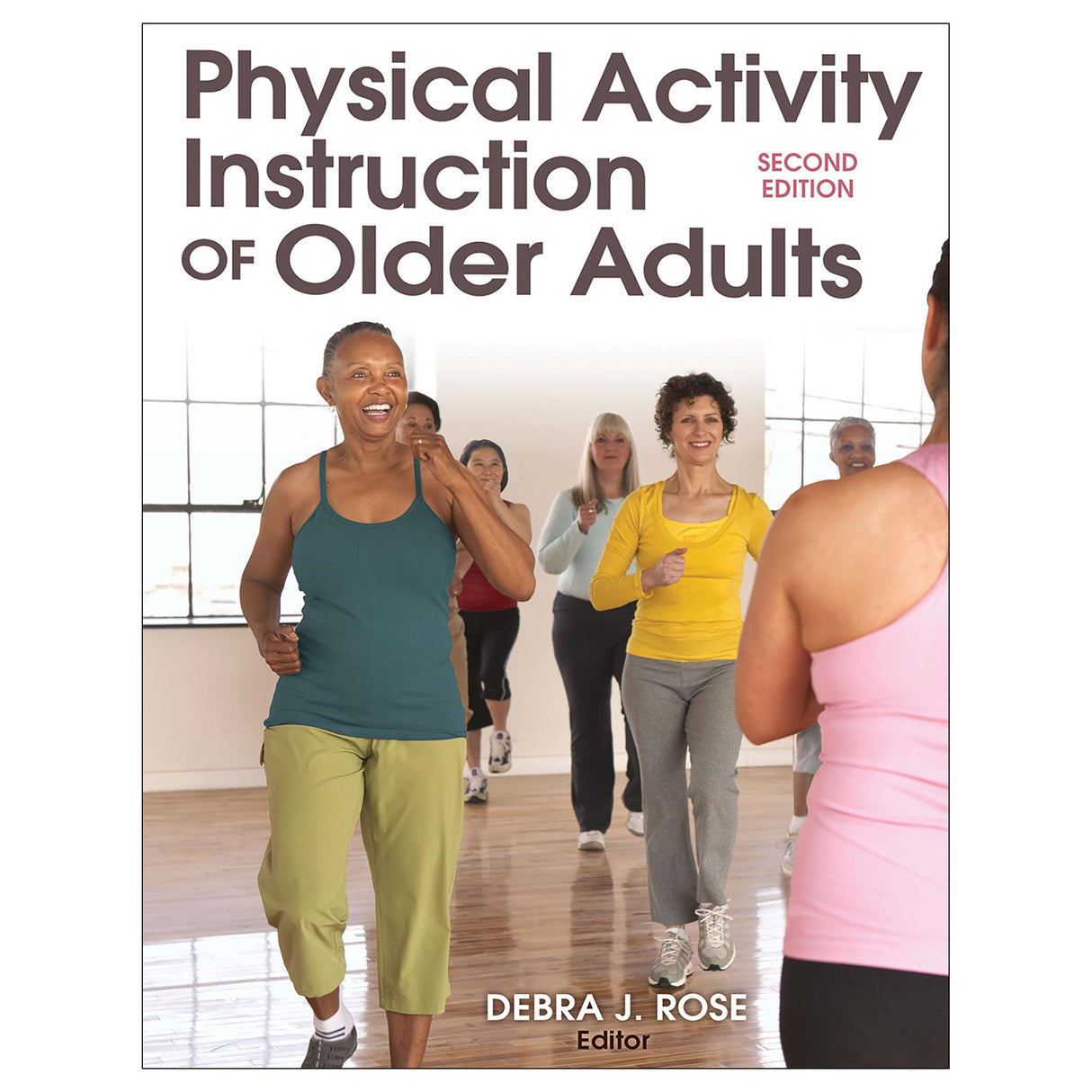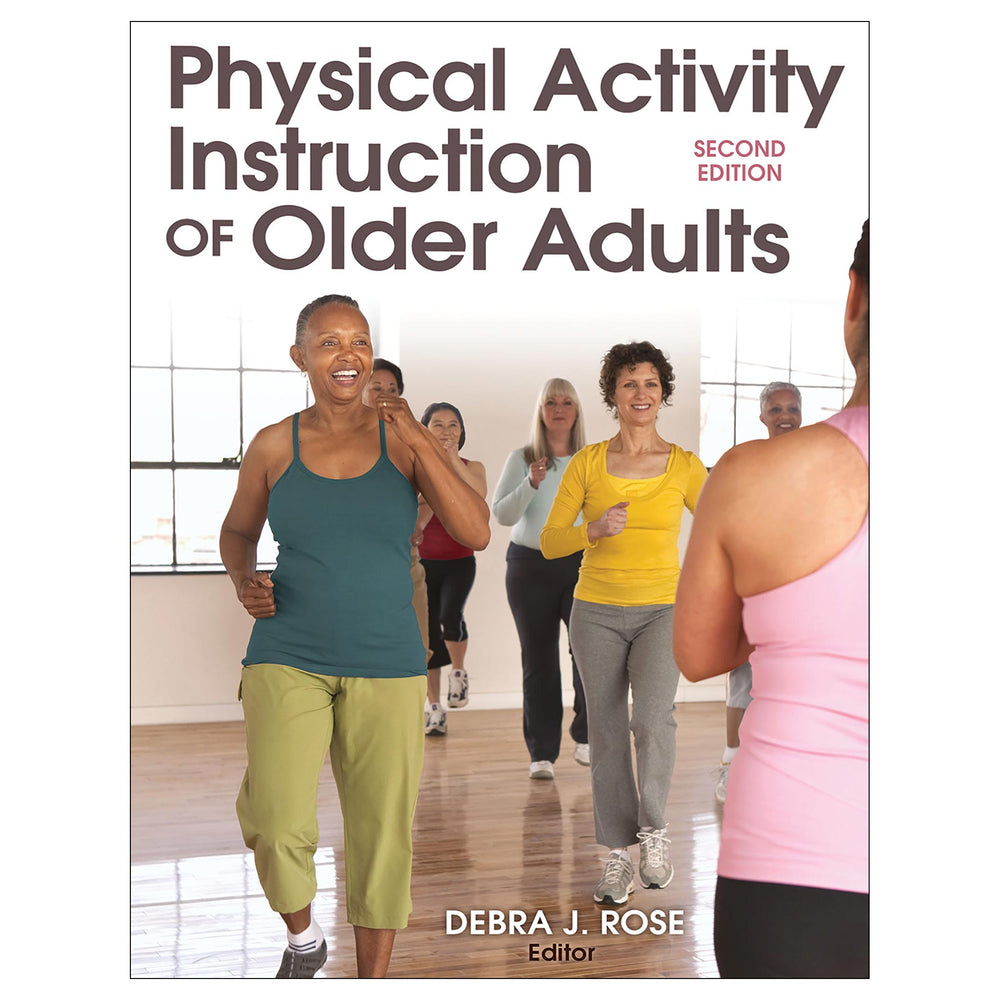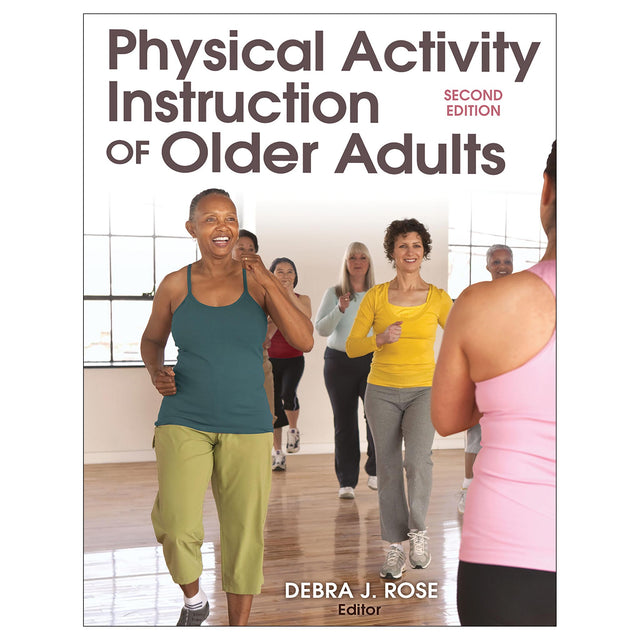Physical Activity Instruction of Older Adults-2nd Edition
Author: Debra J. Rose
$99.00 CAD
Physical Activity Instruction of Older Adults, Second Edition, is the most comprehensive text available for current and future fitness professionals who want to design and implement effective, safe, and fun physical activity programs for older adults with diverse functional capabilities.
Along with an updated review of the research and literature, the second edition introduces a new chapter on the concept of whole-person wellness. It offers strategies for integrating the six dimensions of whole-person wellness (physical, emotional, intellectual, vocational, spiritual, and social) into health promotion and physical activity programs for older adults.
This cohesive blend of theory, practical content, and detailed instruction is divided into four parts, each of which addresses one or more of the nine training modules that comprise International Curriculum Guidelines for Preparing Physical Activity Instructors of Older Adults, the expert-developed guidelines on which this text is based:
• Part I presents an overview of the physiological aspects of aging and the field of gerokinesiology to help readers understand the psychosocial and cognitive benefits derived from regular physical activity.
• Part II leads readers through the process of conducting preexercise health screenings and assessments, providing meaningful feedback to clients, evaluating program outcomes, and helping clients develop short- and long-term behavioral goals.
• Part III emphasizes programming principles and training methods that will facilitate the development of well-rounded and effective exercise programs. It includes specific activities for engaging older adults mentally, emotionally, socially, and spiritually along with myriad dynamic and static flexibility exercises to address joint and muscle flexibility, muscle strength, balance, mobility, endurance, and power.
• Part IV focuses on the teaching, motivation, communication, and leadership skills that are necessary for creating effective and safe programs for older adults, with or without specific medical conditions.
The text also offers a variety of features devised to enhance reader understanding and learning retention. Chapters begin with a list of objectives to familiarize readers with the key concepts they will learn, and each chapter concludes with thought-provoking study questions and practical application activities to help readers use the information with real-world scenarios to prepare them to design well-rounded physical activity programs. Other student-friendly elements include chapter summaries and key terms. The content is supplemented with photos, figures, and tables, making the book interesting and visually appealing. Those graphical elements are included in an image bank for instructors to use in creating customized presentations for their course.
Physical Activity Instruction of Older Adults, Second Edition, offers students and fitness professionals a contemporary approach that embraces a comprehensive wellness framework for designing health promotion and physical activity programs for older adults.
Earn continuing education credits/units! A continuing education exam that uses this book is also available. It may be purchased separately or as part of a package that includes both the book and exam.
Audience
Text for certification providers and universities offering courses relating to physical activity and older adults; also a reference for physical activity instructors, fitness specialists, personal trainers, activity directors, activity assistants, and therapeutic recreation specialists working with older adults.
Part I. Overview of Aging and Physical Activity
Chapter 1. The Field of Gerokinesiology
Debra J. Rose and Dawn A. Skelton
Demographics of Older Adults
Benefits of Physical Activity
Defining Old Age
Gerokinesiology: An Expanding Field of Study
Curriculum Development
Later Life Training Curricula: The Gold Standard for Instructor Training?
Career Opportunities
Summary
Key Terms
Recommended Reading
Study Questions
Application Activities
Chapter 2. Predictors of Successful Aging
Debra J. Rose
Biological Theories of Aging
Psychological Theories of Aging
Sociological Theories of Aging
Models of Successful Aging
Physical Activity as a Determinant of Successful Aging
Summary
Key Terms
Recommended Reading
Study Questions
Application Activities
Chapter 3. Psychological and Sociocultural Aspects of Physical Activity for Older Adults
Kathleen S. Wilson
Aging Stereotypes
Psychosocial Benefits of Physical Activity
Promoting Physical Activity
Summary
Key Terms
Recommended Reading
Study Questions
Application Activities
Chapter 4. Physiological Aspects of Aging
Priscilla G. MacRae
Cardiovascular Function
Respiratory Function
Muscle Function
Skeletal Function
Nervous System Function
Summary
Key Terms
Recommended Reading
Study Questions
Application Activities
Part II. Screening, Assessment, and Goal Setting
Chapter 5. Preexercise and Health Screening
Debra J. Rose
Preexercise Screening
Screening Steps
Additional Screening Tools
Implications for Program Design and Management
Summary
Key Terms
Recommended Reading
Study Questions
Application Activities
Chapter 6. Physical and Functional Assessments
C. Jessie Jones and Roberta E. Rikli
Functional Fitness Framework
Considerations for Test Selection and Evaluation
Recommended Assessment Tools
Guidelines for Group Physical Performance Testing
Interpreting Test Results
Summary
Key Terms
Recommended Reading
Study Questions
Application Activities
Chapter 7. Goal Setting and Behavioral Management
Sara Wilcox and Abby C. King
Factors Influencing Older Adults’ Exercise Participation
Theoretical Frameworks for Behavior Change
Physically Active Lifestyles
Implications for Program Design and Management
Summary
Key Terms
Recommended Reading
Study Questions
Application Activities
Part III. Core Program Principles and Training Methods
Chapter 8. Important Considerations When Designing Exercise Programs for Older Adults
Debra J. Rose
Heterogeneity of Older Adults
Optimizing Physical Function Through Exercise
Exercise Principles for Program Design
Specific Exercise Principles for Older Adults
Summary
Key Terms
Recommended Reading
Study Questions
Application Activities
Chapter 9. Whole-Person Wellness for Successful Aging
Janis M. Montague, Debra J. Rose, and Judy Aprile
Wellness: A Change in Perspective and Perception
Defining Wellness: A Historical Perspective
Whole-Person Wellness: A Comprehensive Perspective
Whole-Person Wellness and Successful Aging: A Winning Combination
Defining the Dimensions of Wellness
Applying the Dimensions of Wellness
Summary
Key Terms
Recommended Reading
Study Questions
Application Activities
Chapter 10. Principles of the Warm-Up and Cool-Down
Mary Ann Kluge
Warming Up
Goal Setting
Assessing Participant Readiness
Increasing the Challenge
Engaging Participants Socially and Emotionally
New Warm-Up Strategies
Cooling Down
Summary
Key Terms
Recommended Reading
Study Questions
Application Activities
Chapter 11. Flexibility Training
Debra J. Rose
Age-Associated Changes in Flexibility
Types of Stretching Techniques
Incorporating Flexibility Training Into the Exercise Program
Examples of Flexibility Exercises
Summary
Key Terms
Recommended Reading
Study Questions
Application Activities
Chapter 12. Resistance Training
Joseph Signorile
Benefits of Resistance Training
Principles of Resistance Training
Training Variables
Resistance Training Conditions and Modalities
Resistance Training for Older Adults
Summary
Key Terms
Recommended Reading
Study Questions
Application Activities
Chapter 13. Aerobic Endurance Training
Susie Dinan-Young and Dawn A. Skelton
Benefits of Aerobic Endurance Training for Older Adults
Principles and Considerations for Aerobic Endurance Training
Variables for Aerobic Endurance Training
Training Precautions and Considerations
Implications for Program Design and Management
Summary
Key Terms
Recommended Reading
Study Questions
Application Activities
Chapter 14. Balance and Mobility Training
Debra J. Rose
Age-Associated Changes in Balance and Mobility
Balance and Mobility Exercises
Manipulating the Challenge in a Group Setting
Summary
Key Terms
Recommended Reading
Study Questions
Application Activities
Part IV. Program Design, Leadership, and Risk Management
Chapter 15. Applying Movement Analysis and Motor Learning Principles to Program Design
Debra J. Rose
Nervous and Musculoskeletal System Changes and Motor Skill Learning
Movement Analysis of Skills
Motor Learning Principles for the Physical Activity Instructor
Summary
Key Terms
Recommended Reading
Study Questions
Application Activities
Chapter 16. Teaching and Leadership Skills
Helen Hawley-Hague and Susie Dinan-Young
Developing Your Leadership Style
Developing Your Instructional Methods, Techniques, and Strategies
Advancing Your Instructional Skills and Strategies
Developing Your Leadership Skills
Summary
Key Terms
Recommended Reading
Study Questions
Application Activities
Chapter 17. Exercise Considerations for Medical Conditions
Matthew J. Peterson
Cardiovascular Conditions
Pulmonary Disorders
Diabetes
Musculoskeletal Conditions
Neurological and Cognitive Conditions
Summary
Key Terms
Recommended Reading
Study Questions
Application Activities
Chapter 18. Legal Standards, Risk Management, and Professional Ethics
Debra J. Rose
The Law and the Physical Activity Instructor
Risk Management Plans
Ethical Guidelines for the Physical Activity Instructor
Summary
Key Terms
Recommended Reading
Study Questions
Application Activities
Appendix A. International Curriculum Guidelines for Preparing Physical Activity Instructors of Older Adults
Appendix B. IDEA Code of Ethics for Personal Trainers
Appendix C. IDEA Code of Ethics for Group Fitness Instructors
Image bank. Includes all of the images from the text—sorted by chapter—to provide instructors with flexibility when creating their own customized presentations, handouts, and other course resources.





